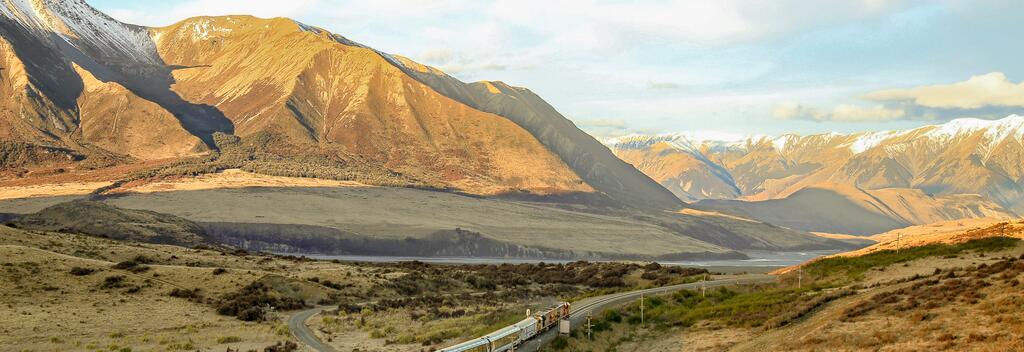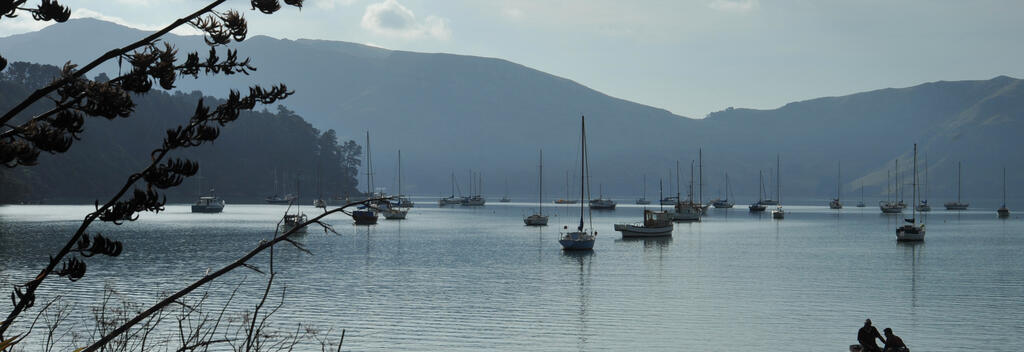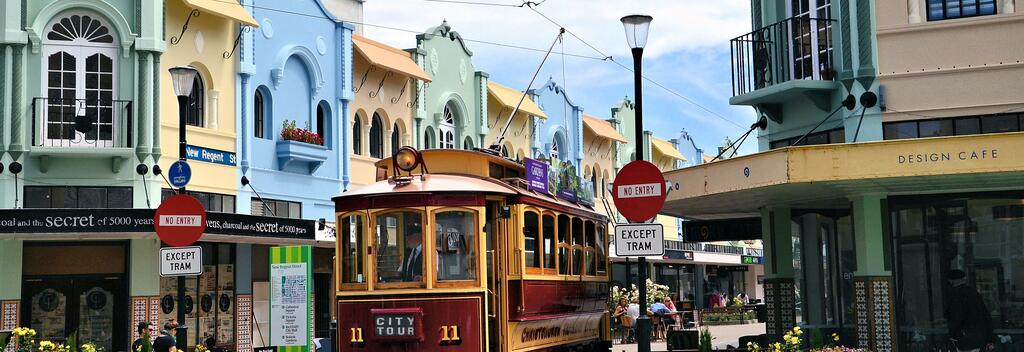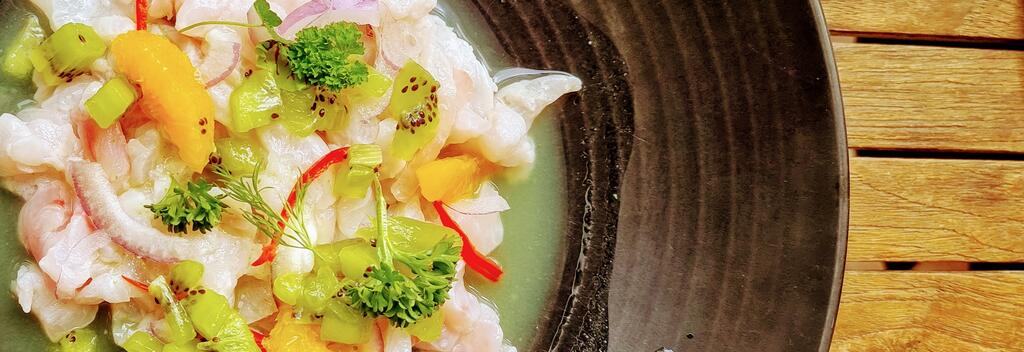-
Popular places to visit
Popular things to do
Helpful tips
Here's a few useful links to help with planning your trip to Aotearoa New Zealand.
-
Ōtautahi Christchurch has something for everyone, from outdoor adventures and family fun to trendy bars and great places to eat.


For anyone who loves to cook (or eat), Riverside Market(opens in new window) is a must-visit location. Comprising 40 carefully curated stalls, Riverside Market has the best of everything, including organic produce, meat, seafood, baked goods, coffee, cured meats, and chocolate. Highlights include Sheep’s milk gelato, Argentinian-style slow cooked beef, and something called a cookie pie – and, yes, it is exactly as it sounds.
Although the Alpine Pacific Touring Route(opens in new window) is technically a road trip, you’ll want to spend most of your time on foot. The touring route, which goes along the coast from Christchurch to Kaikoura then inland to the alpine village of Hanmer Springs, is chock-full of amazing walking (and cycling) tracks that show off the region’s spectacular and varied scenery. Highlights include rugged headlands, steep sea-facing cliffs, ancient native forest, and snow-capped mountains. There’s also plenty to do when you decide to put your feet up. No visit to Kaikoura is complete without tasting the local crayfish, which is everywhere and part of every cuisine, from crayfish ravioli to crayfish barbeque. Just as no visit to Hanmer Springs can happen without a dip in the town’s thermal mineral waters. In the evenings, sample the Pinot Noir and Riesling you picked up in Waipara, North Canterbury’s wine region. Thankfully, by luck or by design, you’ll pass through Waipara again on your return to Christchurch, so you can pick up another bottle of your favourite drop.


The TranzAlpine(opens in new window) train journey from Christchurch to Greymouth is widely regarded as one of the most scenic railway journeys in the world. The journey takes less than five hours and features a hit list of striking natural landscapes, including ancient rainforest, vast plains, tightly knotted rivers, snow-capped alps, vertigo-inducing gorges, and aquamarine alpine lakes. And, like all great train journeys, it has its share of Victorian-looking viaducts and tunnels. Of the fifteen tunnels, the longest covers 8.5 km – just long enough to make you slightly uncomfortable and long for the light.
Little High Eatery(opens in new window) is an upmarket version of a food court that serves everything from dumplings and sushi to pizza and burgers. The smart way to dine here is to order something small from a few different counters, and then go back for more. The court also has bars and coffee vendors, so there really is no need to go anywhere else.


Akaroa is no longer a French settlement, but it still has a charming South of France vibe, excellent local cheeses, and sophisticated eateries. You’ll find contentment wandering down the Rue Lavaud and the Rue Jolie, admiring lemon-coloured colonial houses and their antique roses, stopping for excellent pastries and coffee, or diving into one of the town’s French-themed seafood restaurants – a specialty thanks to the town’s harbour-side location. In between eating and drinking, you can swim with Hector's Dolphins, stroll out to the lighthouse, or take one of the town’s day walks along the peninsula.


Unlike the famous Regent Street in London, New Regent Street(opens in new window) is not the home of flagship stores and international brands, thankfully. Instead, it offers an eclectic mix of boutique stores and bars and restaurants. Purpose built as a pedestrian high street in the 1930s, New Regent Street is lined with ornate pastel-coloured buildings in a Spanish architectural style. The vibe is European, but it has the right amount of organic ruggedness to not feel stultified by gentrification. Highlights in triplicate are Rollickin Gelato(opens in new window), which has developed a cult status after evolving from a makeshift cart. And Twenty Steven Steps(opens in new window), an effortlessly cool upscale restaurant, famed for its relaxed take on fine dining. And The Last Word(opens in new window), an unusual but pleasing combination of cosy whisky den and sophisticated cocktail lounge.


If swimming with dolphins is on your bucket list, try a Black Cat Cruise(opens in new window). They’ll take you out into the Akaroa Harbour to see one of the world’s smallest and rarest dolphins, the Hector’s Dolphin. These tours are exactly how swimming with dolphins should be. If the dolphins don’t want to play, the boat will leave the area. Nothing is forced. And if dolphin calves are around, swimming isn’t permitted either. Protecting the Hector’s Dolphin is a passion for Black Cat Cruises, who campaign tirelessly to protect the dolphins and their habitat.


When it comes to the Arts Centre(opens in new window) it is hard to know what to talk about first. It’s a fine heritage building, built in 1877 out of bluestone and native dark wood, and in the style of the time, a maze of corridors and grand staircases. The building is the former home of University of Canterbury, the alma mater of Earnest Rutherford, the first person to split the atom. Today, it houses an impressive collection of galleries and boutique stores. Also in residence is the The Observatory Hotel, a cute boutique hotel that treads the line between casual and elegant. Plus, the centre has a lively events programme, which includes open-air concerts, talks, festivals, exhibitions, and art classes – many of which are free!


On a Pohatu Penguins(opens in new window) tour you’ll be shown the country’s largest mainland colony of Little Blue Penguins by the people credited with their survival. The owners of this family-run business have spent three decades working to protect the Pohatu Penguin colony. Work that has been funded (and continues to be funded) through tours like this one. Starting at Akaroa, you’ll travel along the scenic backcountry roads of Banks Peninsula – a destination in itself – to the Pōhatu marine reserve, a tranquil bay on south-eastern most corner of the peninsula. Guides will show you the best viewing spots and tell you about their heroic efforts to save the penguins.


An Āmiki Cultural Food Tour(opens in new window) is the best way to discover Ōtautahi Christchurch. You’ll walk, talk, and eat your way through the city with a local Māori historian, who’ll explain how the city’s present-day bricks and mortar reflect the region’s rich history and culture. The Āmiki guides are excellent storytellers – after all, Āmiki means storytelling in Māori. Plus, each tour is different, tailored to the interests of the visitors – so, there’s no well-worn recitations from official scripts here, but living and breathing tours that are constantly changing. Along the way, you’ll sample kai (Māori cuisine) and by the end of the tour, your belly will be as full as your mind.
Getting around New Zealand is easy with familiar road signs and a great range of transport options available.
There are plenty of accommodation options for every budget and travel style.
Visit in Spring or Autumn to enjoy warm weather, spectacular colours, lower prices & short queues.
Looking for deals